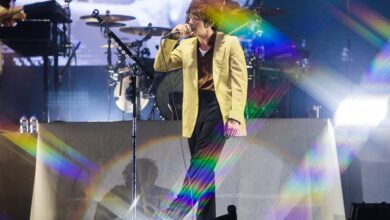‘This is not music’: 30 years of Aphex Twin’s Selected Ambient Works

On 24 April 1993, graphic designer Paul Nicholson was standing on stage at Osmoze, a stygian and hazily remembered Paris club, wearing nothing but a pair of oversized skater shorts and a feral scowl. He was accompanied by his pal Richard, who was using a beige personal computer and a tangle of wires and keyboards to trigger oscillations of synthesised chaos. The audience gawped at the two young Englishmen, with their stringy hair and intense gazes. The mood was a mix of anger and befuddlement.
“It was a strange night. At that time, the French taste was more towards a funk style of house,” recalls Nicholson. “Even before we played the gig there were members of the sound crew already giving Richard a hard time. The attitude of ‘this is not music’. So when the concert actually happened, Richard ramped up the noise.”
Richard was Richard David James – the pioneering electronica producer and iconoclast known as Aphex Twin. And Nicholson was designer of the Aphex Twin “A” logo that famously adorned James’s landmark album, Selected Ambient Works 85-92 which turns 30 this month. He also briefly held the unofficial position of Aphex Twin on-stage dancer. Which is how he found himself in Paris with his shirt off, staring down a room of discommoded French clubbers.
“Even before we did the gig, we were kind of getting p***ed off with the attitude of the people there,” says Nicholson from his design studio in London. “It was the kind of mood where I wasn’t going to be in any way friendly. My stance was quite aggressive.”
As Nicholson says, there was a lot of aggression in Aphex Twin’s music that evening, too, the drill-bit grooves colliding with torrents of pure noise. Yet this was merely one side of James’s artistic persona. Twelve months previously, with Selected Ambient Works, he’d demonstrated a far subtler touch.
With its ghostly samples of the human voice and disembodied tempos, the 13-track masterpiece was both accessible and inscrutable. Arriving at the height of the house explosion, Selected Ambient Works showed electronic music could be more than ribcage-rattling beats and hands-in-the-air euphoria.
It was also the work of a natural-born outsider, who delighted in wrongfooting his audience by putting out music under a variety of pseudonyms – including AFX, Polygon Window and Blue Calx. James was a self-taught musician from the Cornish town of Redruth, population 14,000. While at school he had created his own instruments out of gutted ZX Spectrum computers and whatever spare parts were to hand.
Those bedroom composer horizons had expanded in his late teens when he discovered clubbing culture. With his friend DJ Tom Middleton (a future house star), he was soon a fixture on the Cornish free party scene, where he would splice his sets with his own gorgeously wonky compositions.
Selected Ambient Works 85-92 was released through Belgian house label R&S and marketed as a compilation. The conceit was that it collected material James had composed all the way back to early adolescence. In fact, most of the compositions were relatively recent. Regardless, the record brimmed with mystery and owed more to the refracted minimalism of Philip Glass and Stockhausen than to house mainstays Frankie Knuckles or 808 State.
James’s first album would grow in stature across the intervening decades. Its legacy lies in the fact that it proved electronic music could take advantage of the long-play format to deliver works of nuance and ambition. In that regard, it paved the way for records by everyone from the Chemical Brothers and Leftfield to Burial and Floating Points. As it marks its anniversary, it thus stands as one of the most important records of the 1990s (while the precise release date is lost in time, the consensus is that it was sometime in early February).
“The thing about Selected Ambient Works 85-92 is that it arrived at exactly the right time. The acid house explosion of 1988 had ushered in an entirely new genre of music, but by 1992 it was beginning to settle and this sort of music was starting to cross over,” says Neil Mason, editor of Electronic Sound, a magazine covering electronic music and culture.
“There’s two records I remember blowing me away at the time. Underworld’s Dubnobasswithmyheadman and Selected Ambient Works and they both seemed to come out of nowhere,” he says. “There’s an accessibility to both those albums. They’re not full of four-to-floor bangers that dominated the rave scene. Dance music came on a 12-inch, so the idea of an album of the stuff was still quite fresh.”
Selected Ambient Works 85-92 packed a quixotic and unsettling punch. It opens with the cooing “Xtal”, built around a Mike Oldfield-esque 1986 piece by composers Steve Jeffries, Mary Carewe and Donald Greig called “Atmospheric – Vocal”. That is followed by “Tha”, a beautifully spasmodic sliver of minimalism riding a mutating drum pattern. Elsewhere compositions such as “Ptolemy” combine frantic rhythms and halcyon atmospherics. No matter how many times you’ve listened, there’s always something new to discover.
“It’s not about grooves or music to dance to. It’s electronic music and that’s not the same as dance music. People do tend to confuse the two things. Just because something’s electronic, it doesn’t necessarily follow that it’s dance music,” continues Mason.
“When he crossed over, Aphex flew in the face of what the common conception of ‘dance music’ was. As did Underworld. They both make music you can dance to, but you don’t have to. Sticking some headphones on and listening is just as good.”
The album cover for ‘Selected Ambient Works’
Aphex Twin didn’t invent the ambient genre. Brian Eno had already pioneered it in the 1970s with records such as Ambient 1: Music for Airports. But Selected Ambient Works and its 1994 follow-up Selected Ambient Works Volume II pushed on from Eno’s meticulous wooziness and broke new ground by tapping into the energy of the clubbing scene.
“There was little that sounded like either record that came out much prior to them, especially Volume II. When we listen to them, not only do we hear them, but we hear an Ur-text for so much that followed,” says writer, critic and ambient music expert Marc Weidenbaum, who wrote about Selected Ambient Works Volume II for Bloomsbury’s 33⅓ series of short books about landmark records. “They resonate with listeners today because we sense so much of their impact on today’s music.”
Yet for all its historical significance, Selected Ambient Works parts one and two are overshadowed slightly. James is today remembered as the demon prince of late 1990s electronica. And that notoriety largely flows from two works of art peripheral to his music.
They are the videos Chris Cunningham directed for the singles “Come to Daddy” (1997) and “Window Licker” (1999). In the former, a man is chased by children wearing unsettling Richard D James masks. For the latter, Cunningham photoshopped James’s bestubbled face onto the body of a model who morphs into a monster.
Aphex flew in the face of what the common conception of ‘dance music’ was
An Aphex Twin set at Coachella, 2008





